Analyzing Organizational Behavior: City College and Enterprise
VerifiedAdded on 2020/01/16
|13
|4415
|157
Report
AI Summary
This report provides an in-depth analysis of organizational behavior, comparing and contrasting the structures and leadership styles adopted by City College and Rent a Car Enterprises. It explores how different leadership approaches, including autocratic, laissez-faire, and participative styles, impact employee behavior and organizational performance. The report examines the influence of organizational structure (flat vs. tall) and culture on communication, decision-making, and overall work environment. It also delves into the application of various management theories such as human relations, systems, and contingency approaches, evaluating their effectiveness in addressing employee needs and achieving organizational goals. The report highlights the importance of adapting to change, employee engagement, and the impact of leadership on fostering a positive and productive workplace, addressing challenges like employee issues and the need for continuous improvement in both educational and corporate settings.
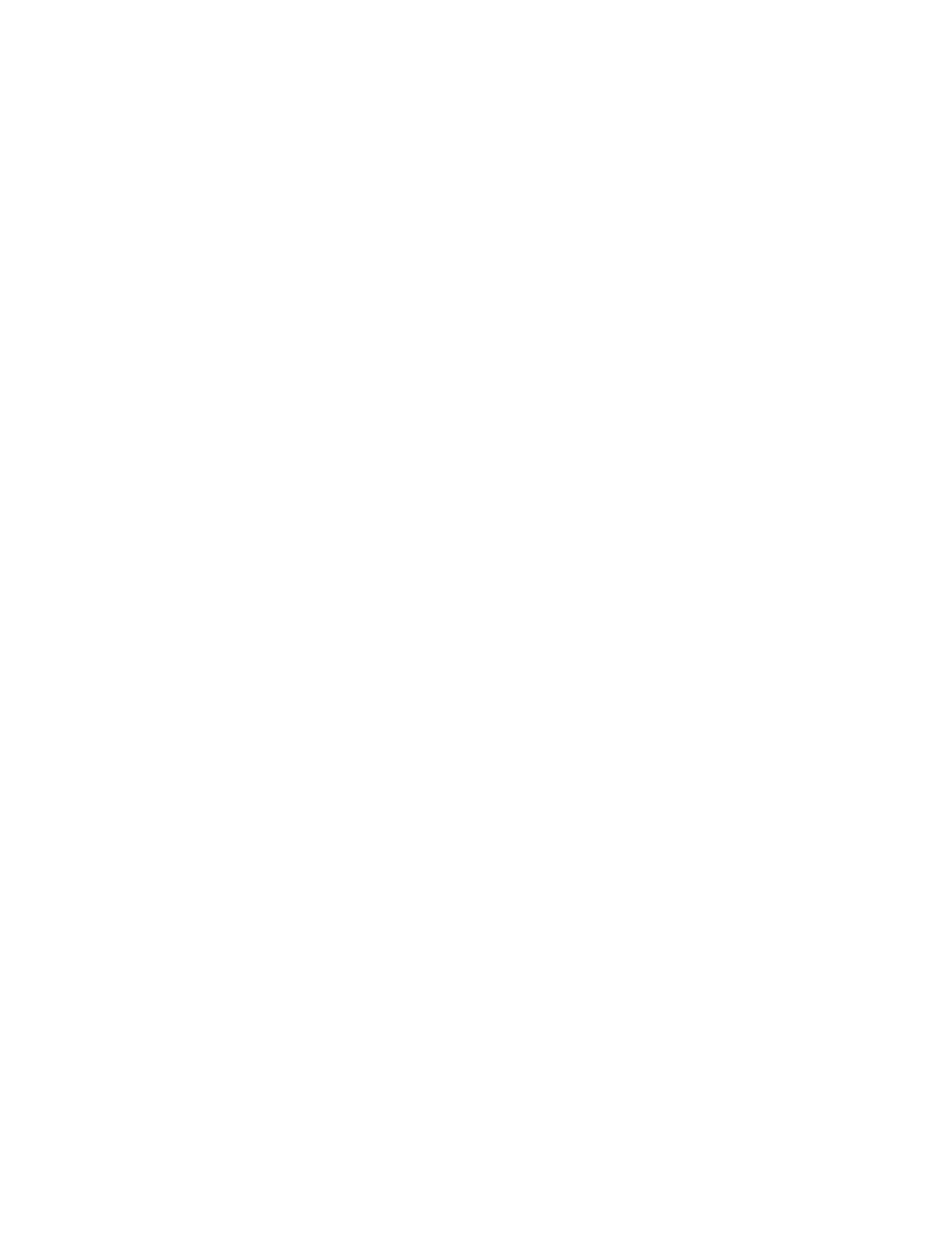
Paraphrase This Document
Need a fresh take? Get an instant paraphrase of this document with our AI Paraphraser
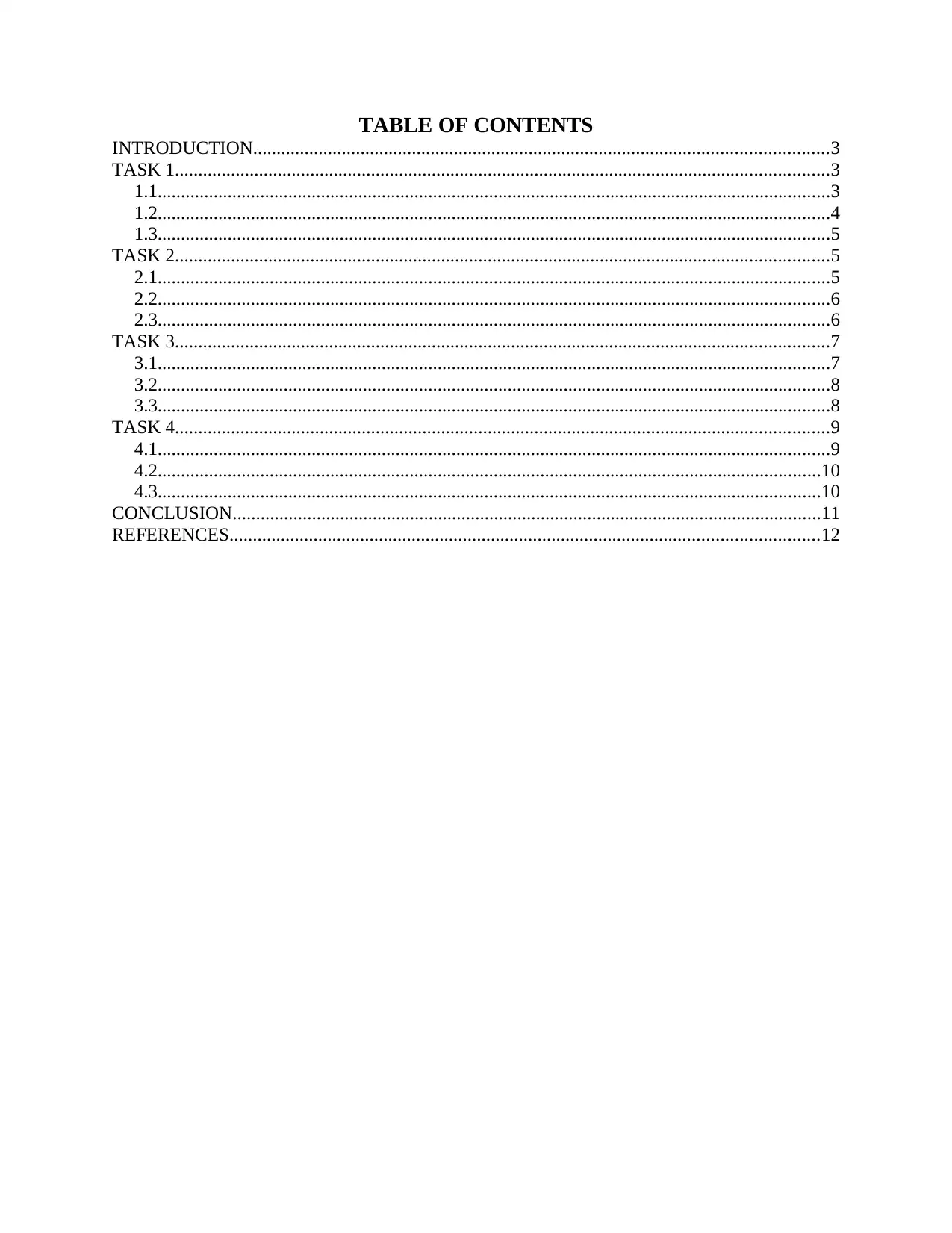
TABLE OF CONTENTS
INTRODUCTION...........................................................................................................................3
TASK 1............................................................................................................................................3
1.1................................................................................................................................................3
1.2................................................................................................................................................4
1.3................................................................................................................................................5
TASK 2............................................................................................................................................5
2.1................................................................................................................................................5
2.2................................................................................................................................................6
2.3................................................................................................................................................6
TASK 3............................................................................................................................................7
3.1................................................................................................................................................7
3.2................................................................................................................................................8
3.3................................................................................................................................................8
TASK 4............................................................................................................................................9
4.1................................................................................................................................................9
4.2..............................................................................................................................................10
4.3..............................................................................................................................................10
CONCLUSION..............................................................................................................................11
REFERENCES..............................................................................................................................12
INTRODUCTION...........................................................................................................................3
TASK 1............................................................................................................................................3
1.1................................................................................................................................................3
1.2................................................................................................................................................4
1.3................................................................................................................................................5
TASK 2............................................................................................................................................5
2.1................................................................................................................................................5
2.2................................................................................................................................................6
2.3................................................................................................................................................6
TASK 3............................................................................................................................................7
3.1................................................................................................................................................7
3.2................................................................................................................................................8
3.3................................................................................................................................................8
TASK 4............................................................................................................................................9
4.1................................................................................................................................................9
4.2..............................................................................................................................................10
4.3..............................................................................................................................................10
CONCLUSION..............................................................................................................................11
REFERENCES..............................................................................................................................12
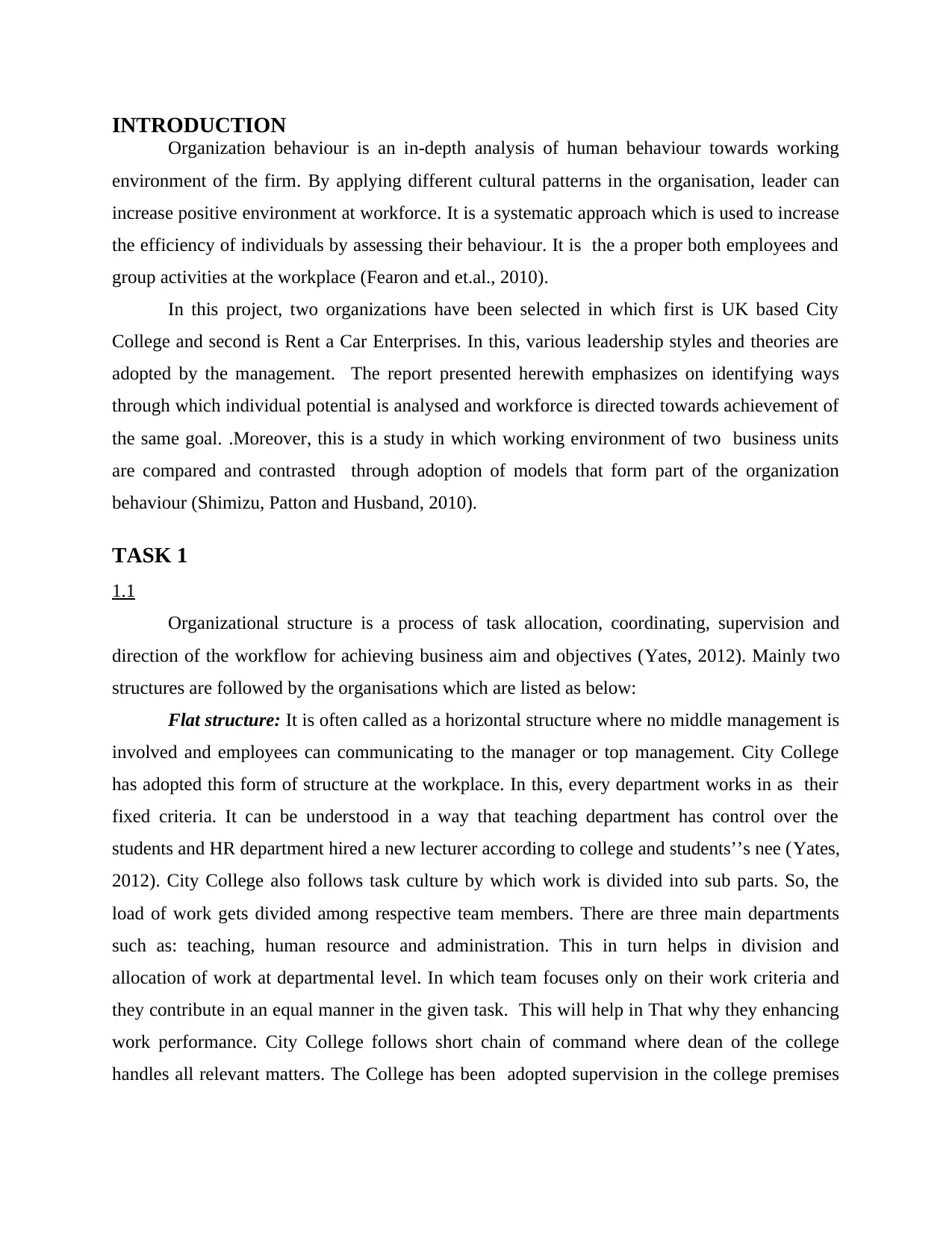
INTRODUCTION
Organization behaviour is an in-depth analysis of human behaviour towards working
environment of the firm. By applying different cultural patterns in the organisation, leader can
increase positive environment at workforce. It is a systematic approach which is used to increase
the efficiency of individuals by assessing their behaviour. It is the a proper both employees and
group activities at the workplace (Fearon and et.al., 2010).
In this project, two organizations have been selected in which first is UK based City
College and second is Rent a Car Enterprises. In this, various leadership styles and theories are
adopted by the management. The report presented herewith emphasizes on identifying ways
through which individual potential is analysed and workforce is directed towards achievement of
the same goal. .Moreover, this is a study in which working environment of two business units
are compared and contrasted through adoption of models that form part of the organization
behaviour (Shimizu, Patton and Husband, 2010).
TASK 1
1.1
Organizational structure is a process of task allocation, coordinating, supervision and
direction of the workflow for achieving business aim and objectives (Yates, 2012). Mainly two
structures are followed by the organisations which are listed as below:
Flat structure: It is often called as a horizontal structure where no middle management is
involved and employees can communicating to the manager or top management. City College
has adopted this form of structure at the workplace. In this, every department works in as their
fixed criteria. It can be understood in a way that teaching department has control over the
students and HR department hired a new lecturer according to college and students’’s nee (Yates,
2012). City College also follows task culture by which work is divided into sub parts. So, the
load of work gets divided among respective team members. There are three main departments
such as: teaching, human resource and administration. This in turn helps in division and
allocation of work at departmental level. In which team focuses only on their work criteria and
they contribute in an equal manner in the given task. This will help in That why they enhancing
work performance. City College follows short chain of command where dean of the college
handles all relevant matters. The College has been adopted supervision in the college premises
Organization behaviour is an in-depth analysis of human behaviour towards working
environment of the firm. By applying different cultural patterns in the organisation, leader can
increase positive environment at workforce. It is a systematic approach which is used to increase
the efficiency of individuals by assessing their behaviour. It is the a proper both employees and
group activities at the workplace (Fearon and et.al., 2010).
In this project, two organizations have been selected in which first is UK based City
College and second is Rent a Car Enterprises. In this, various leadership styles and theories are
adopted by the management. The report presented herewith emphasizes on identifying ways
through which individual potential is analysed and workforce is directed towards achievement of
the same goal. .Moreover, this is a study in which working environment of two business units
are compared and contrasted through adoption of models that form part of the organization
behaviour (Shimizu, Patton and Husband, 2010).
TASK 1
1.1
Organizational structure is a process of task allocation, coordinating, supervision and
direction of the workflow for achieving business aim and objectives (Yates, 2012). Mainly two
structures are followed by the organisations which are listed as below:
Flat structure: It is often called as a horizontal structure where no middle management is
involved and employees can communicating to the manager or top management. City College
has adopted this form of structure at the workplace. In this, every department works in as their
fixed criteria. It can be understood in a way that teaching department has control over the
students and HR department hired a new lecturer according to college and students’’s nee (Yates,
2012). City College also follows task culture by which work is divided into sub parts. So, the
load of work gets divided among respective team members. There are three main departments
such as: teaching, human resource and administration. This in turn helps in division and
allocation of work at departmental level. In which team focuses only on their work criteria and
they contribute in an equal manner in the given task. This will help in That why they enhancing
work performance. City College follows short chain of command where dean of the college
handles all relevant matters. The College has been adopted supervision in the college premises
⊘ This is a preview!⊘
Do you want full access?
Subscribe today to unlock all pages.

Trusted by 1+ million students worldwide
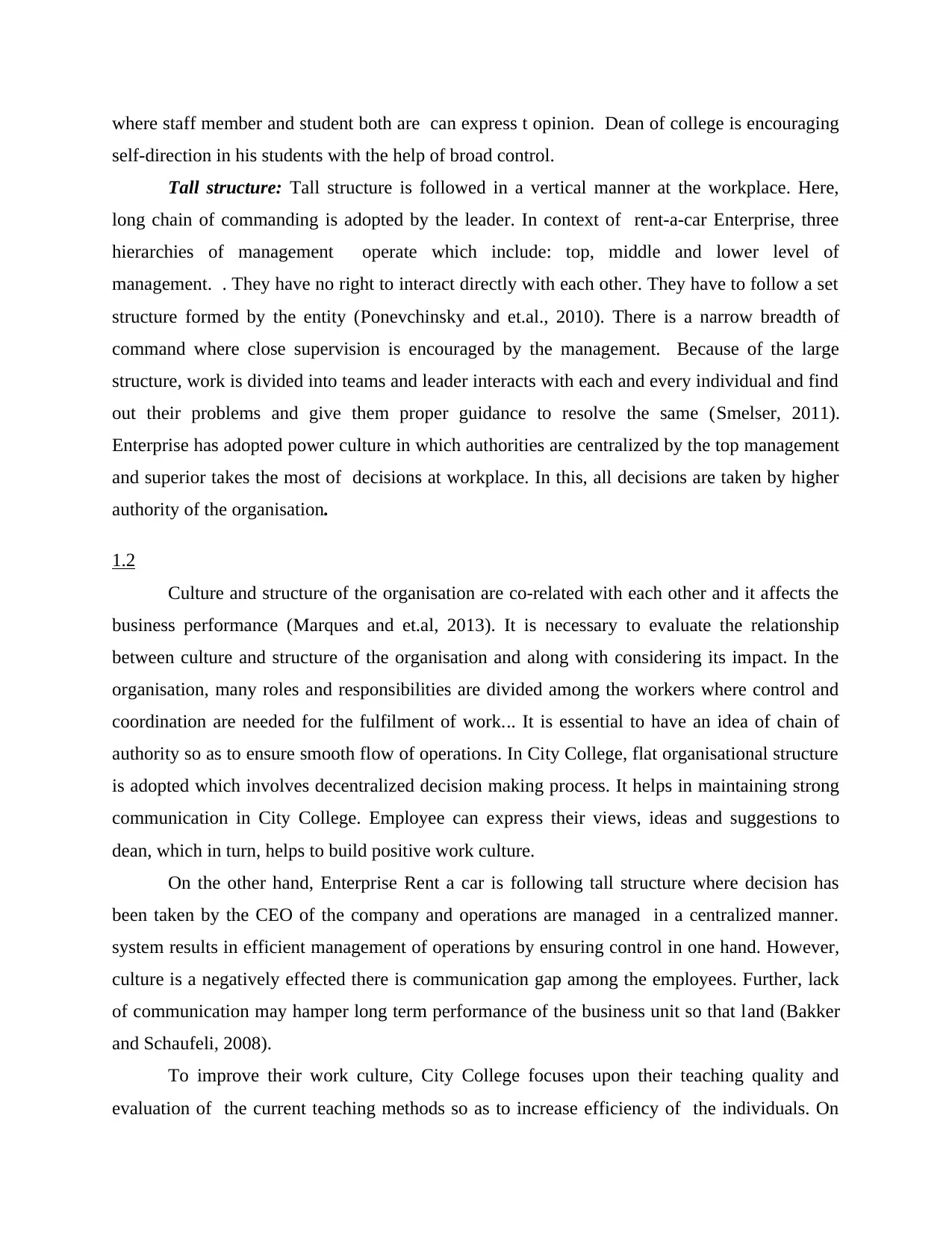
where staff member and student both are can express t opinion. Dean of college is encouraging
self-direction in his students with the help of broad control.
Tall structure: Tall structure is followed in a vertical manner at the workplace. Here,
long chain of commanding is adopted by the leader. In context of rent-a-car Enterprise, three
hierarchies of management operate which include: top, middle and lower level of
management. . They have no right to interact directly with each other. They have to follow a set
structure formed by the entity (Ponevchinsky and et.al., 2010). There is a narrow breadth of
command where close supervision is encouraged by the management. Because of the large
structure, work is divided into teams and leader interacts with each and every individual and find
out their problems and give them proper guidance to resolve the same (Smelser, 2011).
Enterprise has adopted power culture in which authorities are centralized by the top management
and superior takes the most of decisions at workplace. In this, all decisions are taken by higher
authority of the organisation.
1.2
Culture and structure of the organisation are co-related with each other and it affects the
business performance (Marques and et.al, 2013). It is necessary to evaluate the relationship
between culture and structure of the organisation and along with considering its impact. In the
organisation, many roles and responsibilities are divided among the workers where control and
coordination are needed for the fulfilment of work... It is essential to have an idea of chain of
authority so as to ensure smooth flow of operations. In City College, flat organisational structure
is adopted which involves decentralized decision making process. It helps in maintaining strong
communication in City College. Employee can express their views, ideas and suggestions to
dean, which in turn, helps to build positive work culture.
On the other hand, Enterprise Rent a car is following tall structure where decision has
been taken by the CEO of the company and operations are managed in a centralized manner.
system results in efficient management of operations by ensuring control in one hand. However,
culture is a negatively effected there is communication gap among the employees. Further, lack
of communication may hamper long term performance of the business unit so that land (Bakker
and Schaufeli, 2008).
To improve their work culture, City College focuses upon their teaching quality and
evaluation of the current teaching methods so as to increase efficiency of the individuals. On
self-direction in his students with the help of broad control.
Tall structure: Tall structure is followed in a vertical manner at the workplace. Here,
long chain of commanding is adopted by the leader. In context of rent-a-car Enterprise, three
hierarchies of management operate which include: top, middle and lower level of
management. . They have no right to interact directly with each other. They have to follow a set
structure formed by the entity (Ponevchinsky and et.al., 2010). There is a narrow breadth of
command where close supervision is encouraged by the management. Because of the large
structure, work is divided into teams and leader interacts with each and every individual and find
out their problems and give them proper guidance to resolve the same (Smelser, 2011).
Enterprise has adopted power culture in which authorities are centralized by the top management
and superior takes the most of decisions at workplace. In this, all decisions are taken by higher
authority of the organisation.
1.2
Culture and structure of the organisation are co-related with each other and it affects the
business performance (Marques and et.al, 2013). It is necessary to evaluate the relationship
between culture and structure of the organisation and along with considering its impact. In the
organisation, many roles and responsibilities are divided among the workers where control and
coordination are needed for the fulfilment of work... It is essential to have an idea of chain of
authority so as to ensure smooth flow of operations. In City College, flat organisational structure
is adopted which involves decentralized decision making process. It helps in maintaining strong
communication in City College. Employee can express their views, ideas and suggestions to
dean, which in turn, helps to build positive work culture.
On the other hand, Enterprise Rent a car is following tall structure where decision has
been taken by the CEO of the company and operations are managed in a centralized manner.
system results in efficient management of operations by ensuring control in one hand. However,
culture is a negatively effected there is communication gap among the employees. Further, lack
of communication may hamper long term performance of the business unit so that land (Bakker
and Schaufeli, 2008).
To improve their work culture, City College focuses upon their teaching quality and
evaluation of the current teaching methods so as to increase efficiency of the individuals. On
Paraphrase This Document
Need a fresh take? Get an instant paraphrase of this document with our AI Paraphraser
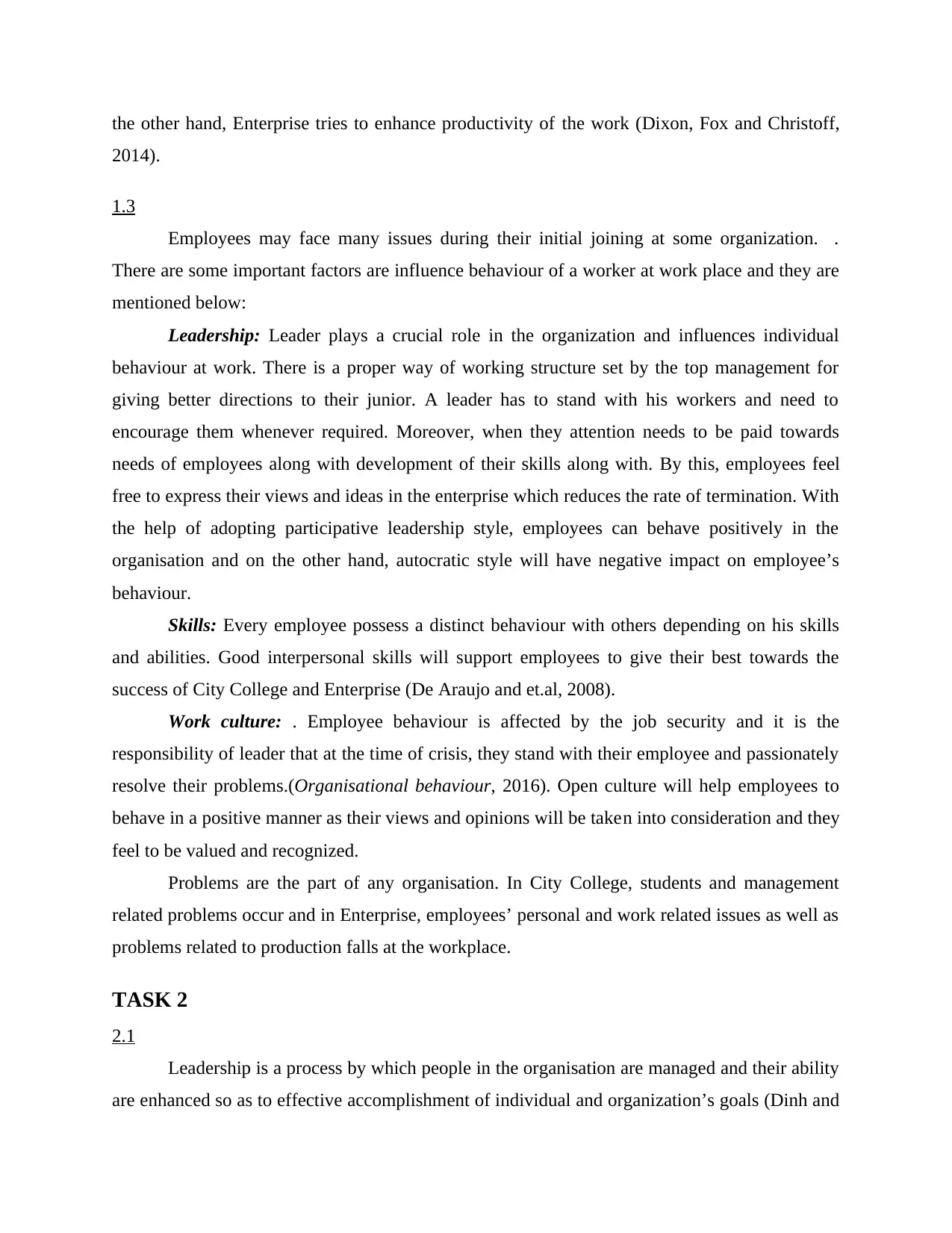
the other hand, Enterprise tries to enhance productivity of the work (Dixon, Fox and Christoff,
2014).
1.3
Employees may face many issues during their initial joining at some organization. .
There are some important factors are influence behaviour of a worker at work place and they are
mentioned below:
Leadership: Leader plays a crucial role in the organization and influences individual
behaviour at work. There is a proper way of working structure set by the top management for
giving better directions to their junior. A leader has to stand with his workers and need to
encourage them whenever required. Moreover, when they attention needs to be paid towards
needs of employees along with development of their skills along with. By this, employees feel
free to express their views and ideas in the enterprise which reduces the rate of termination. With
the help of adopting participative leadership style, employees can behave positively in the
organisation and on the other hand, autocratic style will have negative impact on employee’s
behaviour.
Skills: Every employee possess a distinct behaviour with others depending on his skills
and abilities. Good interpersonal skills will support employees to give their best towards the
success of City College and Enterprise (De Araujo and et.al, 2008).
Work culture: . Employee behaviour is affected by the job security and it is the
responsibility of leader that at the time of crisis, they stand with their employee and passionately
resolve their problems.(Organisational behaviour, 2016). Open culture will help employees to
behave in a positive manner as their views and opinions will be taken into consideration and they
feel to be valued and recognized.
Problems are the part of any organisation. In City College, students and management
related problems occur and in Enterprise, employees’ personal and work related issues as well as
problems related to production falls at the workplace.
TASK 2
2.1
Leadership is a process by which people in the organisation are managed and their ability
are enhanced so as to effective accomplishment of individual and organization’s goals (Dinh and
2014).
1.3
Employees may face many issues during their initial joining at some organization. .
There are some important factors are influence behaviour of a worker at work place and they are
mentioned below:
Leadership: Leader plays a crucial role in the organization and influences individual
behaviour at work. There is a proper way of working structure set by the top management for
giving better directions to their junior. A leader has to stand with his workers and need to
encourage them whenever required. Moreover, when they attention needs to be paid towards
needs of employees along with development of their skills along with. By this, employees feel
free to express their views and ideas in the enterprise which reduces the rate of termination. With
the help of adopting participative leadership style, employees can behave positively in the
organisation and on the other hand, autocratic style will have negative impact on employee’s
behaviour.
Skills: Every employee possess a distinct behaviour with others depending on his skills
and abilities. Good interpersonal skills will support employees to give their best towards the
success of City College and Enterprise (De Araujo and et.al, 2008).
Work culture: . Employee behaviour is affected by the job security and it is the
responsibility of leader that at the time of crisis, they stand with their employee and passionately
resolve their problems.(Organisational behaviour, 2016). Open culture will help employees to
behave in a positive manner as their views and opinions will be taken into consideration and they
feel to be valued and recognized.
Problems are the part of any organisation. In City College, students and management
related problems occur and in Enterprise, employees’ personal and work related issues as well as
problems related to production falls at the workplace.
TASK 2
2.1
Leadership is a process by which people in the organisation are managed and their ability
are enhanced so as to effective accomplishment of individual and organization’s goals (Dinh and
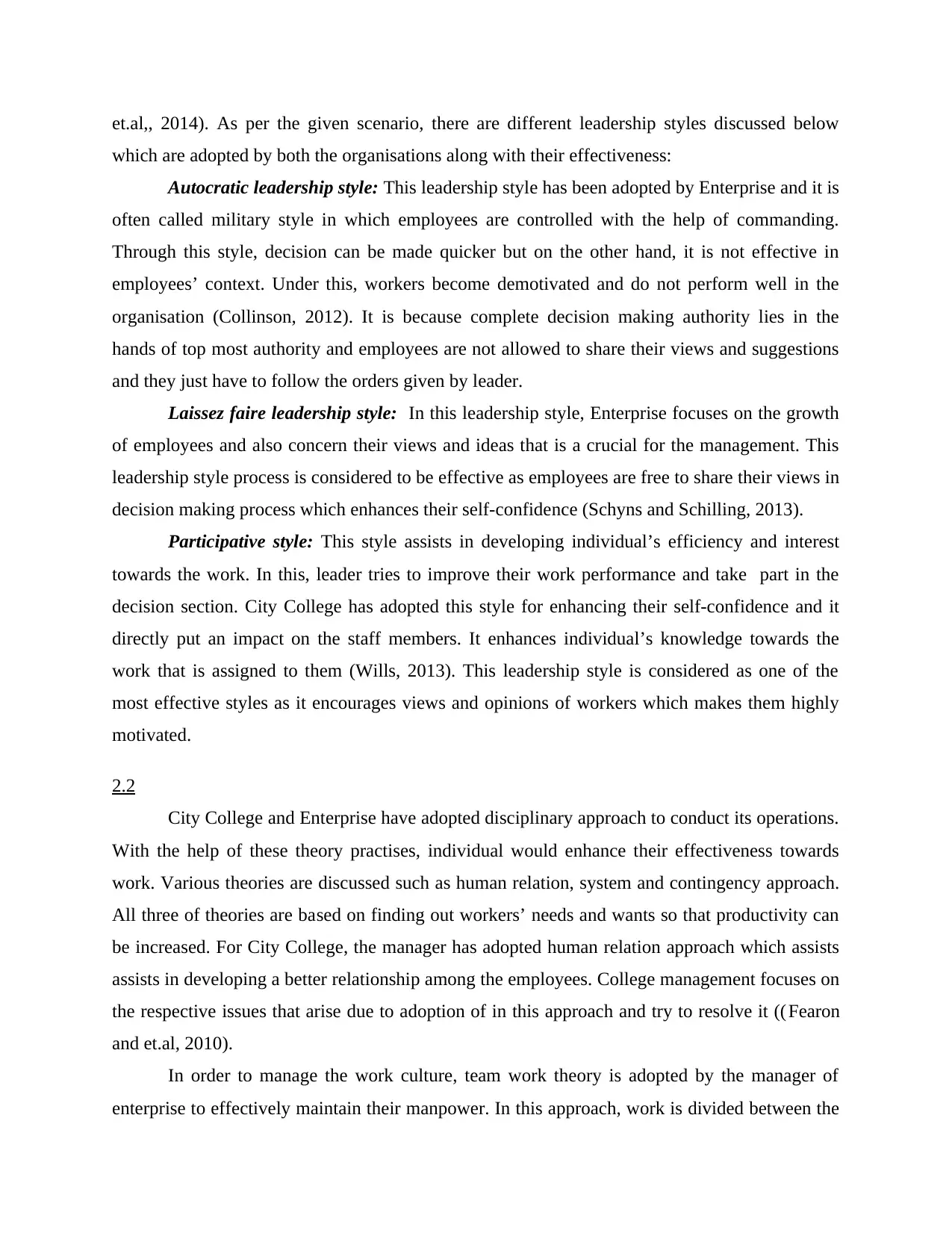
et.al,, 2014). As per the given scenario, there are different leadership styles discussed below
which are adopted by both the organisations along with their effectiveness:
Autocratic leadership style: This leadership style has been adopted by Enterprise and it is
often called military style in which employees are controlled with the help of commanding.
Through this style, decision can be made quicker but on the other hand, it is not effective in
employees’ context. Under this, workers become demotivated and do not perform well in the
organisation (Collinson, 2012). It is because complete decision making authority lies in the
hands of top most authority and employees are not allowed to share their views and suggestions
and they just have to follow the orders given by leader.
Laissez faire leadership style: In this leadership style, Enterprise focuses on the growth
of employees and also concern their views and ideas that is a crucial for the management. This
leadership style process is considered to be effective as employees are free to share their views in
decision making process which enhances their self-confidence (Schyns and Schilling, 2013).
Participative style: This style assists in developing individual’s efficiency and interest
towards the work. In this, leader tries to improve their work performance and take part in the
decision section. City College has adopted this style for enhancing their self-confidence and it
directly put an impact on the staff members. It enhances individual’s knowledge towards the
work that is assigned to them (Wills, 2013). This leadership style is considered as one of the
most effective styles as it encourages views and opinions of workers which makes them highly
motivated.
2.2
City College and Enterprise have adopted disciplinary approach to conduct its operations.
With the help of these theory practises, individual would enhance their effectiveness towards
work. Various theories are discussed such as human relation, system and contingency approach.
All three of theories are based on finding out workers’ needs and wants so that productivity can
be increased. For City College, the manager has adopted human relation approach which assists
assists in developing a better relationship among the employees. College management focuses on
the respective issues that arise due to adoption of in this approach and try to resolve it ((Fearon
and et.al, 2010).
In order to manage the work culture, team work theory is adopted by the manager of
enterprise to effectively maintain their manpower. In this approach, work is divided between the
which are adopted by both the organisations along with their effectiveness:
Autocratic leadership style: This leadership style has been adopted by Enterprise and it is
often called military style in which employees are controlled with the help of commanding.
Through this style, decision can be made quicker but on the other hand, it is not effective in
employees’ context. Under this, workers become demotivated and do not perform well in the
organisation (Collinson, 2012). It is because complete decision making authority lies in the
hands of top most authority and employees are not allowed to share their views and suggestions
and they just have to follow the orders given by leader.
Laissez faire leadership style: In this leadership style, Enterprise focuses on the growth
of employees and also concern their views and ideas that is a crucial for the management. This
leadership style process is considered to be effective as employees are free to share their views in
decision making process which enhances their self-confidence (Schyns and Schilling, 2013).
Participative style: This style assists in developing individual’s efficiency and interest
towards the work. In this, leader tries to improve their work performance and take part in the
decision section. City College has adopted this style for enhancing their self-confidence and it
directly put an impact on the staff members. It enhances individual’s knowledge towards the
work that is assigned to them (Wills, 2013). This leadership style is considered as one of the
most effective styles as it encourages views and opinions of workers which makes them highly
motivated.
2.2
City College and Enterprise have adopted disciplinary approach to conduct its operations.
With the help of these theory practises, individual would enhance their effectiveness towards
work. Various theories are discussed such as human relation, system and contingency approach.
All three of theories are based on finding out workers’ needs and wants so that productivity can
be increased. For City College, the manager has adopted human relation approach which assists
assists in developing a better relationship among the employees. College management focuses on
the respective issues that arise due to adoption of in this approach and try to resolve it ((Fearon
and et.al, 2010).
In order to manage the work culture, team work theory is adopted by the manager of
enterprise to effectively maintain their manpower. In this approach, work is divided between the
⊘ This is a preview!⊘
Do you want full access?
Subscribe today to unlock all pages.

Trusted by 1+ million students worldwide
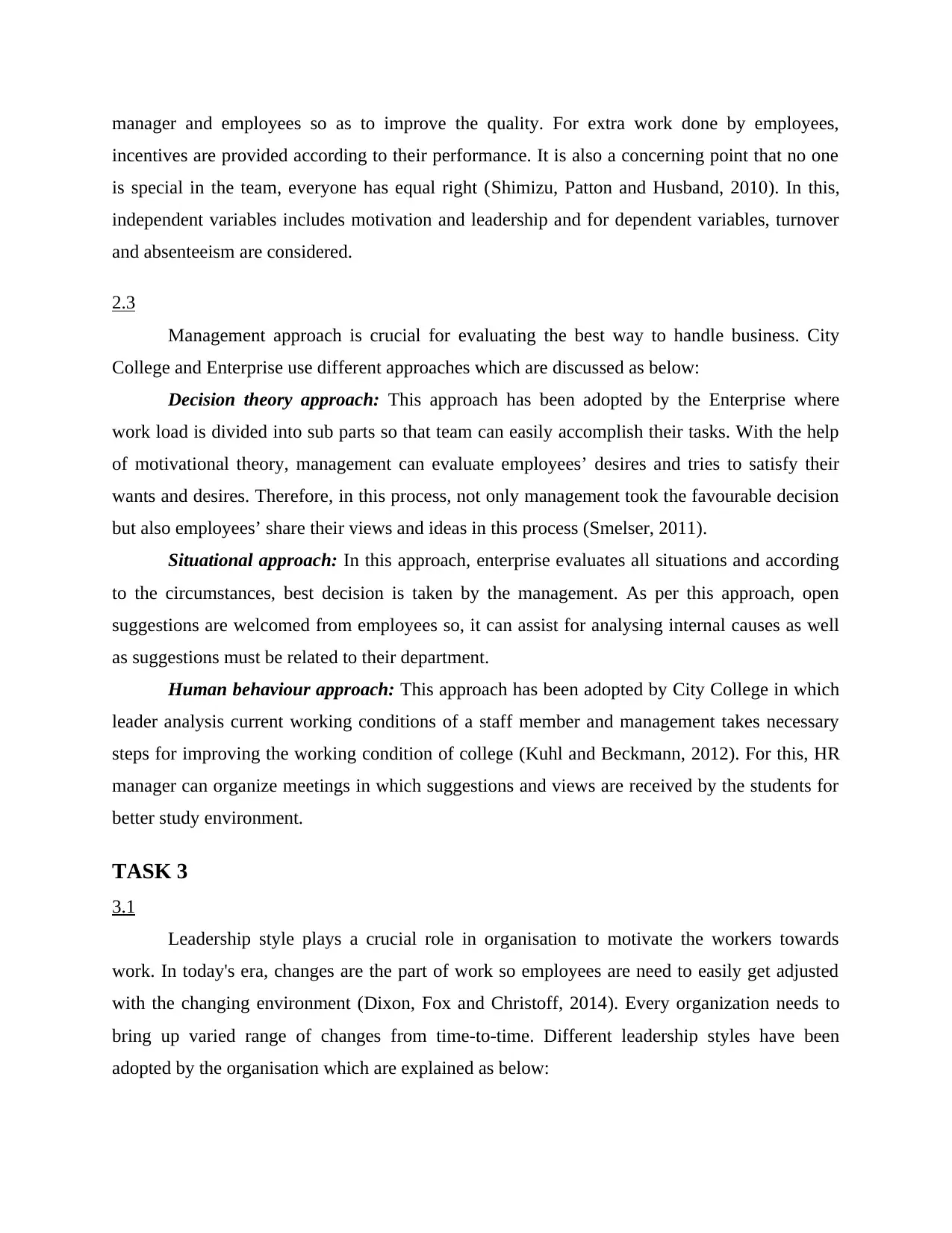
manager and employees so as to improve the quality. For extra work done by employees,
incentives are provided according to their performance. It is also a concerning point that no one
is special in the team, everyone has equal right (Shimizu, Patton and Husband, 2010). In this,
independent variables includes motivation and leadership and for dependent variables, turnover
and absenteeism are considered.
2.3
Management approach is crucial for evaluating the best way to handle business. City
College and Enterprise use different approaches which are discussed as below:
Decision theory approach: This approach has been adopted by the Enterprise where
work load is divided into sub parts so that team can easily accomplish their tasks. With the help
of motivational theory, management can evaluate employees’ desires and tries to satisfy their
wants and desires. Therefore, in this process, not only management took the favourable decision
but also employees’ share their views and ideas in this process (Smelser, 2011).
Situational approach: In this approach, enterprise evaluates all situations and according
to the circumstances, best decision is taken by the management. As per this approach, open
suggestions are welcomed from employees so, it can assist for analysing internal causes as well
as suggestions must be related to their department.
Human behaviour approach: This approach has been adopted by City College in which
leader analysis current working conditions of a staff member and management takes necessary
steps for improving the working condition of college (Kuhl and Beckmann, 2012). For this, HR
manager can organize meetings in which suggestions and views are received by the students for
better study environment.
TASK 3
3.1
Leadership style plays a crucial role in organisation to motivate the workers towards
work. In today's era, changes are the part of work so employees are need to easily get adjusted
with the changing environment (Dixon, Fox and Christoff, 2014). Every organization needs to
bring up varied range of changes from time-to-time. Different leadership styles have been
adopted by the organisation which are explained as below:
incentives are provided according to their performance. It is also a concerning point that no one
is special in the team, everyone has equal right (Shimizu, Patton and Husband, 2010). In this,
independent variables includes motivation and leadership and for dependent variables, turnover
and absenteeism are considered.
2.3
Management approach is crucial for evaluating the best way to handle business. City
College and Enterprise use different approaches which are discussed as below:
Decision theory approach: This approach has been adopted by the Enterprise where
work load is divided into sub parts so that team can easily accomplish their tasks. With the help
of motivational theory, management can evaluate employees’ desires and tries to satisfy their
wants and desires. Therefore, in this process, not only management took the favourable decision
but also employees’ share their views and ideas in this process (Smelser, 2011).
Situational approach: In this approach, enterprise evaluates all situations and according
to the circumstances, best decision is taken by the management. As per this approach, open
suggestions are welcomed from employees so, it can assist for analysing internal causes as well
as suggestions must be related to their department.
Human behaviour approach: This approach has been adopted by City College in which
leader analysis current working conditions of a staff member and management takes necessary
steps for improving the working condition of college (Kuhl and Beckmann, 2012). For this, HR
manager can organize meetings in which suggestions and views are received by the students for
better study environment.
TASK 3
3.1
Leadership style plays a crucial role in organisation to motivate the workers towards
work. In today's era, changes are the part of work so employees are need to easily get adjusted
with the changing environment (Dixon, Fox and Christoff, 2014). Every organization needs to
bring up varied range of changes from time-to-time. Different leadership styles have been
adopted by the organisation which are explained as below:
Paraphrase This Document
Need a fresh take? Get an instant paraphrase of this document with our AI Paraphraser
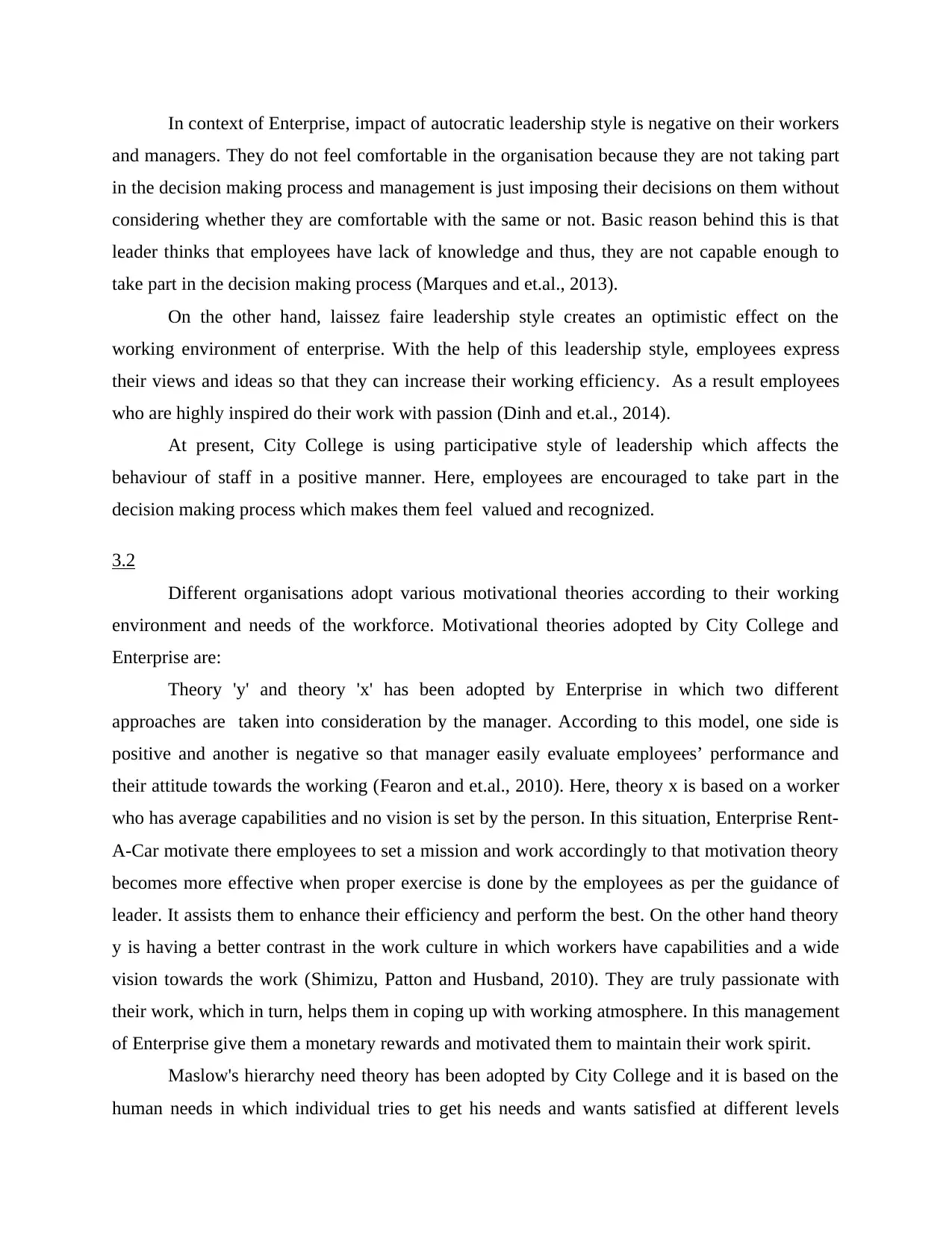
In context of Enterprise, impact of autocratic leadership style is negative on their workers
and managers. They do not feel comfortable in the organisation because they are not taking part
in the decision making process and management is just imposing their decisions on them without
considering whether they are comfortable with the same or not. Basic reason behind this is that
leader thinks that employees have lack of knowledge and thus, they are not capable enough to
take part in the decision making process (Marques and et.al., 2013).
On the other hand, laissez faire leadership style creates an optimistic effect on the
working environment of enterprise. With the help of this leadership style, employees express
their views and ideas so that they can increase their working efficiency. As a result employees
who are highly inspired do their work with passion (Dinh and et.al., 2014).
At present, City College is using participative style of leadership which affects the
behaviour of staff in a positive manner. Here, employees are encouraged to take part in the
decision making process which makes them feel valued and recognized.
3.2
Different organisations adopt various motivational theories according to their working
environment and needs of the workforce. Motivational theories adopted by City College and
Enterprise are:
Theory 'y' and theory 'x' has been adopted by Enterprise in which two different
approaches are taken into consideration by the manager. According to this model, one side is
positive and another is negative so that manager easily evaluate employees’ performance and
their attitude towards the working (Fearon and et.al., 2010). Here, theory x is based on a worker
who has average capabilities and no vision is set by the person. In this situation, Enterprise Rent-
A-Car motivate there employees to set a mission and work accordingly to that motivation theory
becomes more effective when proper exercise is done by the employees as per the guidance of
leader. It assists them to enhance their efficiency and perform the best. On the other hand theory
y is having a better contrast in the work culture in which workers have capabilities and a wide
vision towards the work (Shimizu, Patton and Husband, 2010). They are truly passionate with
their work, which in turn, helps them in coping up with working atmosphere. In this management
of Enterprise give them a monetary rewards and motivated them to maintain their work spirit.
Maslow's hierarchy need theory has been adopted by City College and it is based on the
human needs in which individual tries to get his needs and wants satisfied at different levels
and managers. They do not feel comfortable in the organisation because they are not taking part
in the decision making process and management is just imposing their decisions on them without
considering whether they are comfortable with the same or not. Basic reason behind this is that
leader thinks that employees have lack of knowledge and thus, they are not capable enough to
take part in the decision making process (Marques and et.al., 2013).
On the other hand, laissez faire leadership style creates an optimistic effect on the
working environment of enterprise. With the help of this leadership style, employees express
their views and ideas so that they can increase their working efficiency. As a result employees
who are highly inspired do their work with passion (Dinh and et.al., 2014).
At present, City College is using participative style of leadership which affects the
behaviour of staff in a positive manner. Here, employees are encouraged to take part in the
decision making process which makes them feel valued and recognized.
3.2
Different organisations adopt various motivational theories according to their working
environment and needs of the workforce. Motivational theories adopted by City College and
Enterprise are:
Theory 'y' and theory 'x' has been adopted by Enterprise in which two different
approaches are taken into consideration by the manager. According to this model, one side is
positive and another is negative so that manager easily evaluate employees’ performance and
their attitude towards the working (Fearon and et.al., 2010). Here, theory x is based on a worker
who has average capabilities and no vision is set by the person. In this situation, Enterprise Rent-
A-Car motivate there employees to set a mission and work accordingly to that motivation theory
becomes more effective when proper exercise is done by the employees as per the guidance of
leader. It assists them to enhance their efficiency and perform the best. On the other hand theory
y is having a better contrast in the work culture in which workers have capabilities and a wide
vision towards the work (Shimizu, Patton and Husband, 2010). They are truly passionate with
their work, which in turn, helps them in coping up with working atmosphere. In this management
of Enterprise give them a monetary rewards and motivated them to maintain their work spirit.
Maslow's hierarchy need theory has been adopted by City College and it is based on the
human needs in which individual tries to get his needs and wants satisfied at different levels
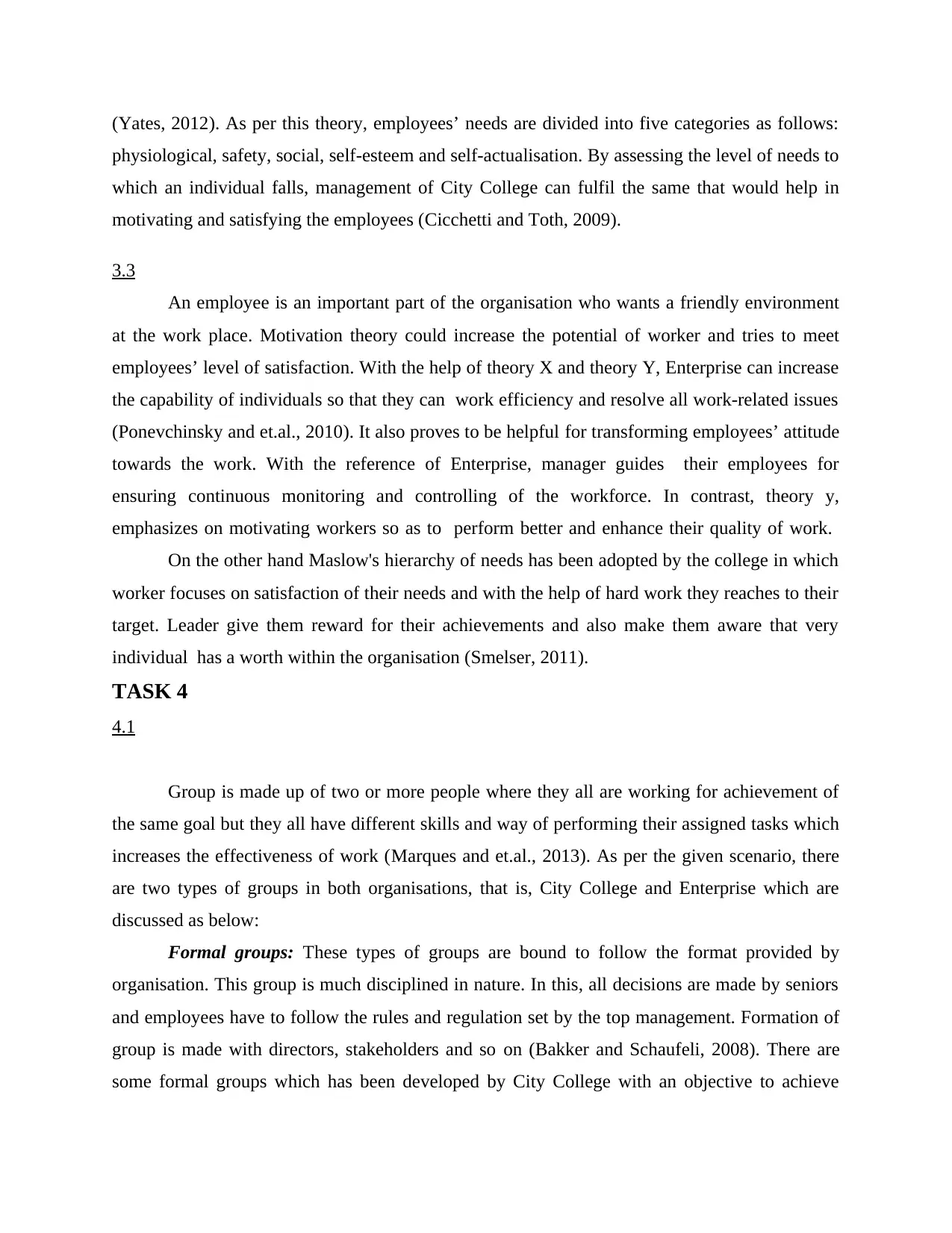
(Yates, 2012). As per this theory, employees’ needs are divided into five categories as follows:
physiological, safety, social, self-esteem and self-actualisation. By assessing the level of needs to
which an individual falls, management of City College can fulfil the same that would help in
motivating and satisfying the employees (Cicchetti and Toth, 2009).
3.3
An employee is an important part of the organisation who wants a friendly environment
at the work place. Motivation theory could increase the potential of worker and tries to meet
employees’ level of satisfaction. With the help of theory X and theory Y, Enterprise can increase
the capability of individuals so that they can work efficiency and resolve all work-related issues
(Ponevchinsky and et.al., 2010). It also proves to be helpful for transforming employees’ attitude
towards the work. With the reference of Enterprise, manager guides their employees for
ensuring continuous monitoring and controlling of the workforce. In contrast, theory y,
emphasizes on motivating workers so as to perform better and enhance their quality of work.
On the other hand Maslow's hierarchy of needs has been adopted by the college in which
worker focuses on satisfaction of their needs and with the help of hard work they reaches to their
target. Leader give them reward for their achievements and also make them aware that very
individual has a worth within the organisation (Smelser, 2011).
TASK 4
4.1
Group is made up of two or more people where they all are working for achievement of
the same goal but they all have different skills and way of performing their assigned tasks which
increases the effectiveness of work (Marques and et.al., 2013). As per the given scenario, there
are two types of groups in both organisations, that is, City College and Enterprise which are
discussed as below:
Formal groups: These types of groups are bound to follow the format provided by
organisation. This group is much disciplined in nature. In this, all decisions are made by seniors
and employees have to follow the rules and regulation set by the top management. Formation of
group is made with directors, stakeholders and so on (Bakker and Schaufeli, 2008). There are
some formal groups which has been developed by City College with an objective to achieve
physiological, safety, social, self-esteem and self-actualisation. By assessing the level of needs to
which an individual falls, management of City College can fulfil the same that would help in
motivating and satisfying the employees (Cicchetti and Toth, 2009).
3.3
An employee is an important part of the organisation who wants a friendly environment
at the work place. Motivation theory could increase the potential of worker and tries to meet
employees’ level of satisfaction. With the help of theory X and theory Y, Enterprise can increase
the capability of individuals so that they can work efficiency and resolve all work-related issues
(Ponevchinsky and et.al., 2010). It also proves to be helpful for transforming employees’ attitude
towards the work. With the reference of Enterprise, manager guides their employees for
ensuring continuous monitoring and controlling of the workforce. In contrast, theory y,
emphasizes on motivating workers so as to perform better and enhance their quality of work.
On the other hand Maslow's hierarchy of needs has been adopted by the college in which
worker focuses on satisfaction of their needs and with the help of hard work they reaches to their
target. Leader give them reward for their achievements and also make them aware that very
individual has a worth within the organisation (Smelser, 2011).
TASK 4
4.1
Group is made up of two or more people where they all are working for achievement of
the same goal but they all have different skills and way of performing their assigned tasks which
increases the effectiveness of work (Marques and et.al., 2013). As per the given scenario, there
are two types of groups in both organisations, that is, City College and Enterprise which are
discussed as below:
Formal groups: These types of groups are bound to follow the format provided by
organisation. This group is much disciplined in nature. In this, all decisions are made by seniors
and employees have to follow the rules and regulation set by the top management. Formation of
group is made with directors, stakeholders and so on (Bakker and Schaufeli, 2008). There are
some formal groups which has been developed by City College with an objective to achieve
⊘ This is a preview!⊘
Do you want full access?
Subscribe today to unlock all pages.

Trusted by 1+ million students worldwide
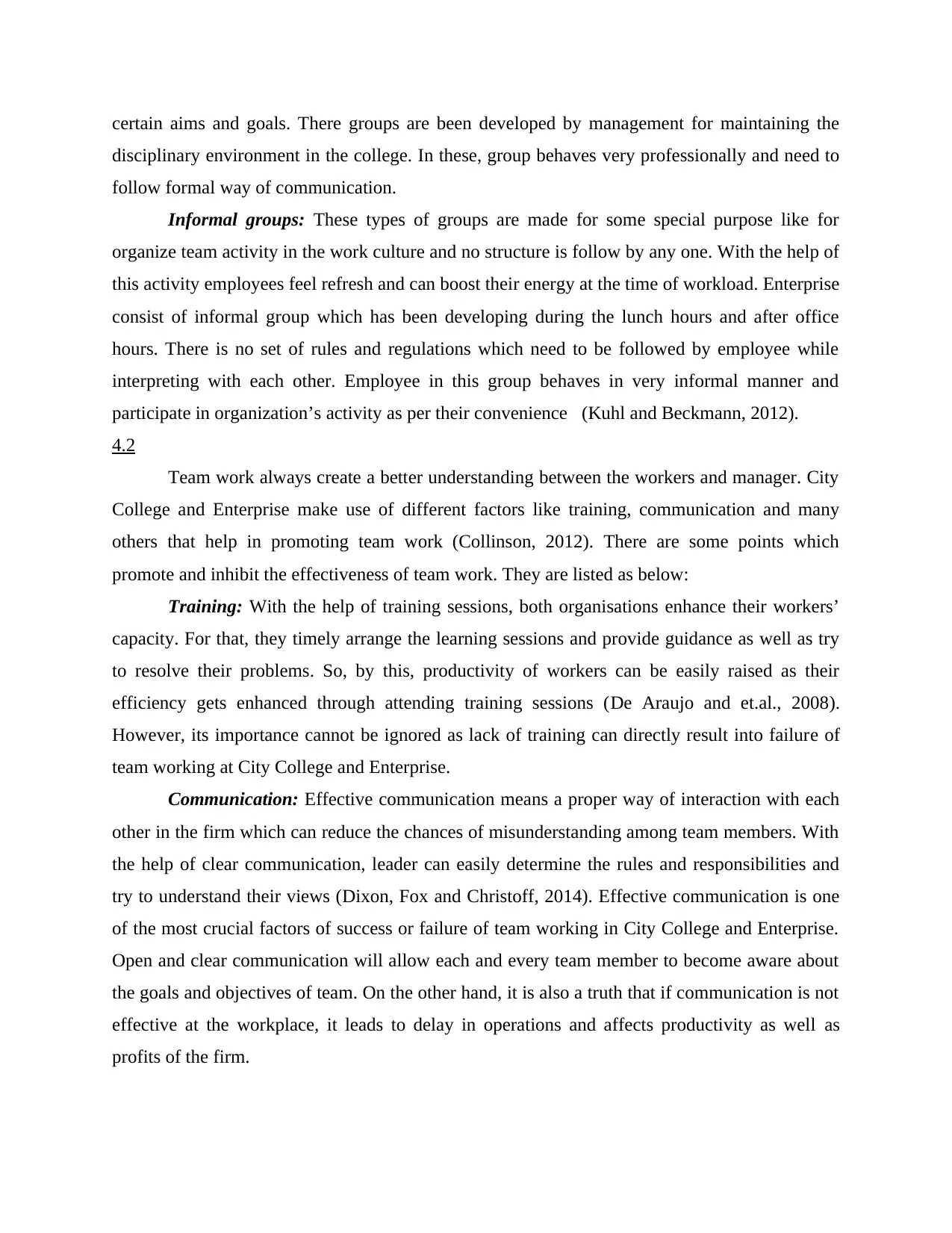
certain aims and goals. There groups are been developed by management for maintaining the
disciplinary environment in the college. In these, group behaves very professionally and need to
follow formal way of communication.
Informal groups: These types of groups are made for some special purpose like for
organize team activity in the work culture and no structure is follow by any one. With the help of
this activity employees feel refresh and can boost their energy at the time of workload. Enterprise
consist of informal group which has been developing during the lunch hours and after office
hours. There is no set of rules and regulations which need to be followed by employee while
interpreting with each other. Employee in this group behaves in very informal manner and
participate in organization’s activity as per their convenience (Kuhl and Beckmann, 2012).
4.2
Team work always create a better understanding between the workers and manager. City
College and Enterprise make use of different factors like training, communication and many
others that help in promoting team work (Collinson, 2012). There are some points which
promote and inhibit the effectiveness of team work. They are listed as below:
Training: With the help of training sessions, both organisations enhance their workers’
capacity. For that, they timely arrange the learning sessions and provide guidance as well as try
to resolve their problems. So, by this, productivity of workers can be easily raised as their
efficiency gets enhanced through attending training sessions (De Araujo and et.al., 2008).
However, its importance cannot be ignored as lack of training can directly result into failure of
team working at City College and Enterprise.
Communication: Effective communication means a proper way of interaction with each
other in the firm which can reduce the chances of misunderstanding among team members. With
the help of clear communication, leader can easily determine the rules and responsibilities and
try to understand their views (Dixon, Fox and Christoff, 2014). Effective communication is one
of the most crucial factors of success or failure of team working in City College and Enterprise.
Open and clear communication will allow each and every team member to become aware about
the goals and objectives of team. On the other hand, it is also a truth that if communication is not
effective at the workplace, it leads to delay in operations and affects productivity as well as
profits of the firm.
disciplinary environment in the college. In these, group behaves very professionally and need to
follow formal way of communication.
Informal groups: These types of groups are made for some special purpose like for
organize team activity in the work culture and no structure is follow by any one. With the help of
this activity employees feel refresh and can boost their energy at the time of workload. Enterprise
consist of informal group which has been developing during the lunch hours and after office
hours. There is no set of rules and regulations which need to be followed by employee while
interpreting with each other. Employee in this group behaves in very informal manner and
participate in organization’s activity as per their convenience (Kuhl and Beckmann, 2012).
4.2
Team work always create a better understanding between the workers and manager. City
College and Enterprise make use of different factors like training, communication and many
others that help in promoting team work (Collinson, 2012). There are some points which
promote and inhibit the effectiveness of team work. They are listed as below:
Training: With the help of training sessions, both organisations enhance their workers’
capacity. For that, they timely arrange the learning sessions and provide guidance as well as try
to resolve their problems. So, by this, productivity of workers can be easily raised as their
efficiency gets enhanced through attending training sessions (De Araujo and et.al., 2008).
However, its importance cannot be ignored as lack of training can directly result into failure of
team working at City College and Enterprise.
Communication: Effective communication means a proper way of interaction with each
other in the firm which can reduce the chances of misunderstanding among team members. With
the help of clear communication, leader can easily determine the rules and responsibilities and
try to understand their views (Dixon, Fox and Christoff, 2014). Effective communication is one
of the most crucial factors of success or failure of team working in City College and Enterprise.
Open and clear communication will allow each and every team member to become aware about
the goals and objectives of team. On the other hand, it is also a truth that if communication is not
effective at the workplace, it leads to delay in operations and affects productivity as well as
profits of the firm.
Paraphrase This Document
Need a fresh take? Get an instant paraphrase of this document with our AI Paraphraser
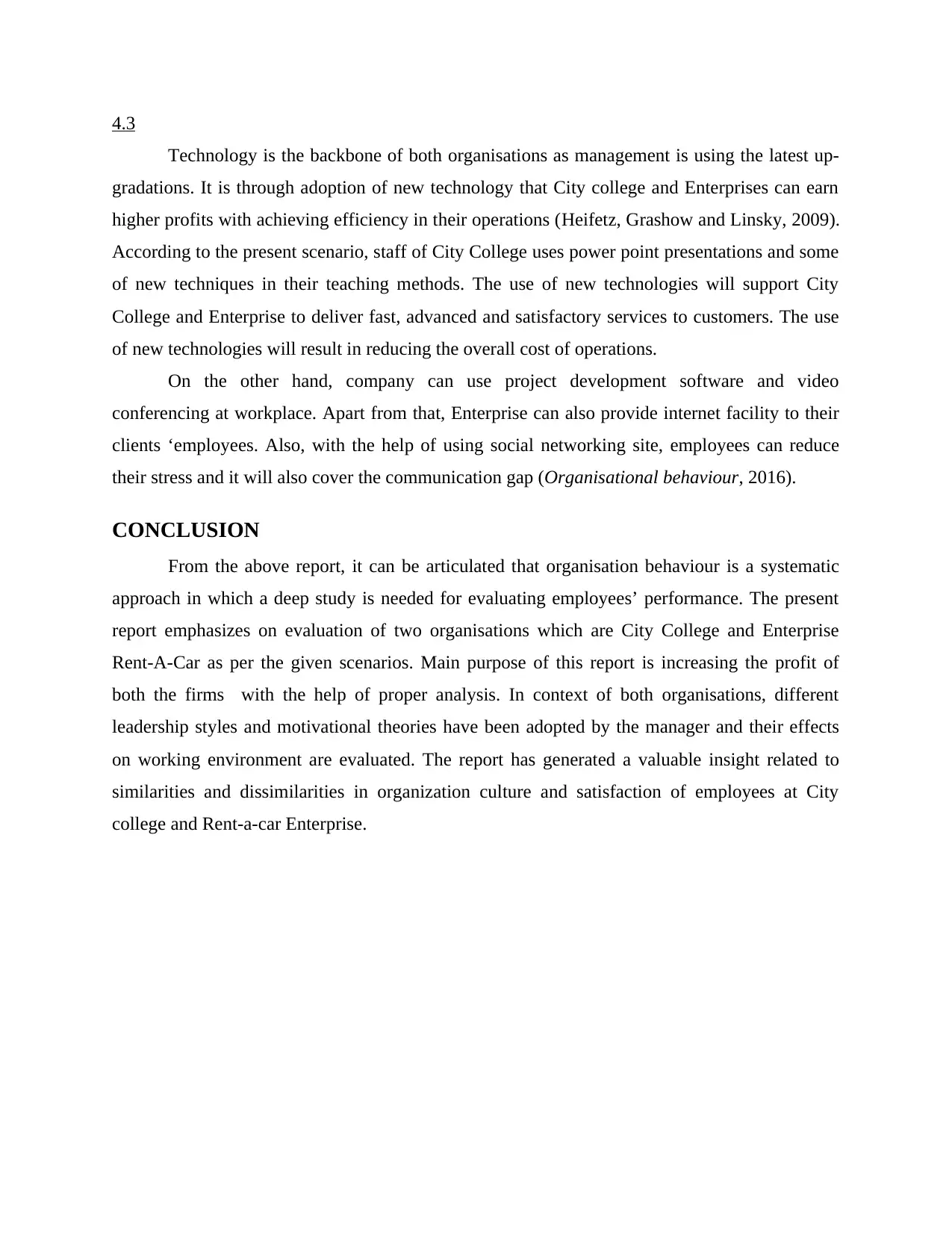
4.3
Technology is the backbone of both organisations as management is using the latest up-
gradations. It is through adoption of new technology that City college and Enterprises can earn
higher profits with achieving efficiency in their operations (Heifetz, Grashow and Linsky, 2009).
According to the present scenario, staff of City College uses power point presentations and some
of new techniques in their teaching methods. The use of new technologies will support City
College and Enterprise to deliver fast, advanced and satisfactory services to customers. The use
of new technologies will result in reducing the overall cost of operations.
On the other hand, company can use project development software and video
conferencing at workplace. Apart from that, Enterprise can also provide internet facility to their
clients ‘employees. Also, with the help of using social networking site, employees can reduce
their stress and it will also cover the communication gap (Organisational behaviour, 2016).
CONCLUSION
From the above report, it can be articulated that organisation behaviour is a systematic
approach in which a deep study is needed for evaluating employees’ performance. The present
report emphasizes on evaluation of two organisations which are City College and Enterprise
Rent-A-Car as per the given scenarios. Main purpose of this report is increasing the profit of
both the firms with the help of proper analysis. In context of both organisations, different
leadership styles and motivational theories have been adopted by the manager and their effects
on working environment are evaluated. The report has generated a valuable insight related to
similarities and dissimilarities in organization culture and satisfaction of employees at City
college and Rent-a-car Enterprise.
Technology is the backbone of both organisations as management is using the latest up-
gradations. It is through adoption of new technology that City college and Enterprises can earn
higher profits with achieving efficiency in their operations (Heifetz, Grashow and Linsky, 2009).
According to the present scenario, staff of City College uses power point presentations and some
of new techniques in their teaching methods. The use of new technologies will support City
College and Enterprise to deliver fast, advanced and satisfactory services to customers. The use
of new technologies will result in reducing the overall cost of operations.
On the other hand, company can use project development software and video
conferencing at workplace. Apart from that, Enterprise can also provide internet facility to their
clients ‘employees. Also, with the help of using social networking site, employees can reduce
their stress and it will also cover the communication gap (Organisational behaviour, 2016).
CONCLUSION
From the above report, it can be articulated that organisation behaviour is a systematic
approach in which a deep study is needed for evaluating employees’ performance. The present
report emphasizes on evaluation of two organisations which are City College and Enterprise
Rent-A-Car as per the given scenarios. Main purpose of this report is increasing the profit of
both the firms with the help of proper analysis. In context of both organisations, different
leadership styles and motivational theories have been adopted by the manager and their effects
on working environment are evaluated. The report has generated a valuable insight related to
similarities and dissimilarities in organization culture and satisfaction of employees at City
college and Rent-a-car Enterprise.
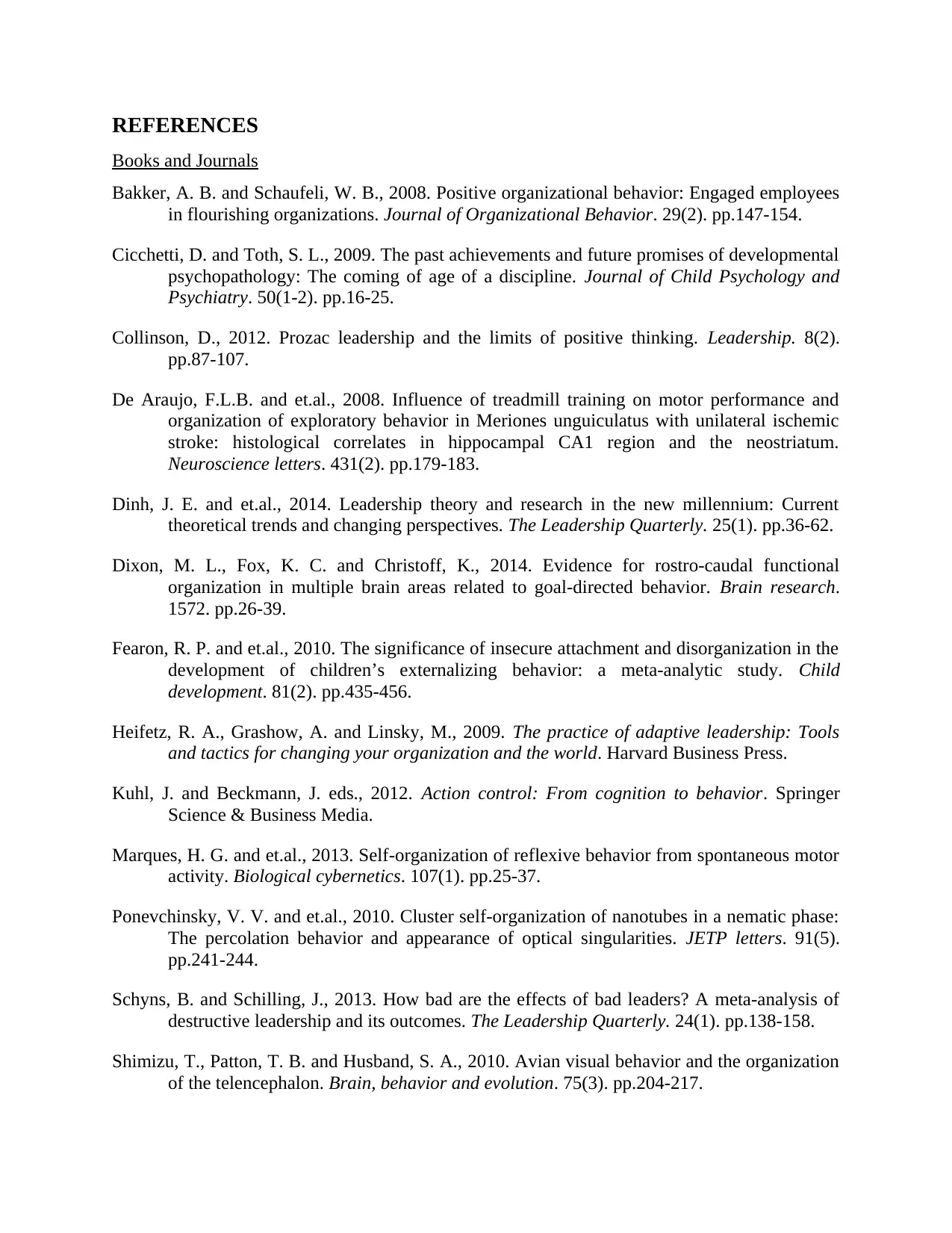
REFERENCES
Books and Journals
Bakker, A. B. and Schaufeli, W. B., 2008. Positive organizational behavior: Engaged employees
in flourishing organizations. Journal of Organizational Behavior. 29(2). pp.147-154.
Cicchetti, D. and Toth, S. L., 2009. The past achievements and future promises of developmental
psychopathology: The coming of age of a discipline. Journal of Child Psychology and
Psychiatry. 50(1‐2). pp.16-25.
Collinson, D., 2012. Prozac leadership and the limits of positive thinking. Leadership. 8(2).
pp.87-107.
De Araujo, F.L.B. and et.al., 2008. Influence of treadmill training on motor performance and
organization of exploratory behavior in Meriones unguiculatus with unilateral ischemic
stroke: histological correlates in hippocampal CA1 region and the neostriatum.
Neuroscience letters. 431(2). pp.179-183.
Dinh, J. E. and et.al., 2014. Leadership theory and research in the new millennium: Current
theoretical trends and changing perspectives. The Leadership Quarterly. 25(1). pp.36-62.
Dixon, M. L., Fox, K. C. and Christoff, K., 2014. Evidence for rostro-caudal functional
organization in multiple brain areas related to goal-directed behavior. Brain research.
1572. pp.26-39.
Fearon, R. P. and et.al., 2010. The significance of insecure attachment and disorganization in the
development of children’s externalizing behavior: a meta‐analytic study. Child
development. 81(2). pp.435-456.
Heifetz, R. A., Grashow, A. and Linsky, M., 2009. The practice of adaptive leadership: Tools
and tactics for changing your organization and the world. Harvard Business Press.
Kuhl, J. and Beckmann, J. eds., 2012. Action control: From cognition to behavior. Springer
Science & Business Media.
Marques, H. G. and et.al., 2013. Self-organization of reflexive behavior from spontaneous motor
activity. Biological cybernetics. 107(1). pp.25-37.
Ponevchinsky, V. V. and et.al., 2010. Cluster self-organization of nanotubes in a nematic phase:
The percolation behavior and appearance of optical singularities. JETP letters. 91(5).
pp.241-244.
Schyns, B. and Schilling, J., 2013. How bad are the effects of bad leaders? A meta-analysis of
destructive leadership and its outcomes. The Leadership Quarterly. 24(1). pp.138-158.
Shimizu, T., Patton, T. B. and Husband, S. A., 2010. Avian visual behavior and the organization
of the telencephalon. Brain, behavior and evolution. 75(3). pp.204-217.
Books and Journals
Bakker, A. B. and Schaufeli, W. B., 2008. Positive organizational behavior: Engaged employees
in flourishing organizations. Journal of Organizational Behavior. 29(2). pp.147-154.
Cicchetti, D. and Toth, S. L., 2009. The past achievements and future promises of developmental
psychopathology: The coming of age of a discipline. Journal of Child Psychology and
Psychiatry. 50(1‐2). pp.16-25.
Collinson, D., 2012. Prozac leadership and the limits of positive thinking. Leadership. 8(2).
pp.87-107.
De Araujo, F.L.B. and et.al., 2008. Influence of treadmill training on motor performance and
organization of exploratory behavior in Meriones unguiculatus with unilateral ischemic
stroke: histological correlates in hippocampal CA1 region and the neostriatum.
Neuroscience letters. 431(2). pp.179-183.
Dinh, J. E. and et.al., 2014. Leadership theory and research in the new millennium: Current
theoretical trends and changing perspectives. The Leadership Quarterly. 25(1). pp.36-62.
Dixon, M. L., Fox, K. C. and Christoff, K., 2014. Evidence for rostro-caudal functional
organization in multiple brain areas related to goal-directed behavior. Brain research.
1572. pp.26-39.
Fearon, R. P. and et.al., 2010. The significance of insecure attachment and disorganization in the
development of children’s externalizing behavior: a meta‐analytic study. Child
development. 81(2). pp.435-456.
Heifetz, R. A., Grashow, A. and Linsky, M., 2009. The practice of adaptive leadership: Tools
and tactics for changing your organization and the world. Harvard Business Press.
Kuhl, J. and Beckmann, J. eds., 2012. Action control: From cognition to behavior. Springer
Science & Business Media.
Marques, H. G. and et.al., 2013. Self-organization of reflexive behavior from spontaneous motor
activity. Biological cybernetics. 107(1). pp.25-37.
Ponevchinsky, V. V. and et.al., 2010. Cluster self-organization of nanotubes in a nematic phase:
The percolation behavior and appearance of optical singularities. JETP letters. 91(5).
pp.241-244.
Schyns, B. and Schilling, J., 2013. How bad are the effects of bad leaders? A meta-analysis of
destructive leadership and its outcomes. The Leadership Quarterly. 24(1). pp.138-158.
Shimizu, T., Patton, T. B. and Husband, S. A., 2010. Avian visual behavior and the organization
of the telencephalon. Brain, behavior and evolution. 75(3). pp.204-217.
⊘ This is a preview!⊘
Do you want full access?
Subscribe today to unlock all pages.

Trusted by 1+ million students worldwide
1 out of 13
Related Documents
Your All-in-One AI-Powered Toolkit for Academic Success.
+13062052269
info@desklib.com
Available 24*7 on WhatsApp / Email
![[object Object]](/_next/static/media/star-bottom.7253800d.svg)
Unlock your academic potential
Copyright © 2020–2025 A2Z Services. All Rights Reserved. Developed and managed by ZUCOL.





